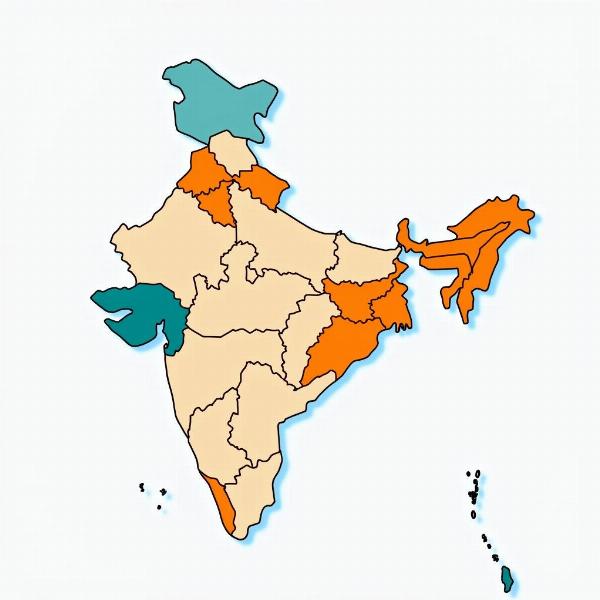Understanding the meaning of “contiguous” is crucial for anyone working with Hindi translations, especially in fields like legal, technical, or geographical contexts. The word “contiguous” implies a direct connection or touching, sharing a common border or edge. This seemingly simple concept can have significant implications depending on the specific context. What exactly does it mean, and how is it used in different scenarios? This article will delve into the various nuances of “contiguous” in Hindi, providing practical examples and exploring its relevance in different fields.
Understanding “Contiguous” in Different Contexts
The Hindi translation of “contiguous” can vary slightly depending on the specific context. Common translations include लगातार (lagatar), which means continuous or consecutive, and संलग्न (sanlagn), meaning attached or adjoining. While both capture the essence of closeness, they may not always be interchangeable. For instance, when describing geographically adjacent regions, संलग्न (sanlagn) might be more appropriate, while लगातार (lagatar) might be better suited for describing a sequence of events.
 Contiguous states in India
Contiguous states in India
Contiguous in Legal Documents
In legal documents, “contiguous” often refers to properties sharing a common boundary. Accurate translation is vital to avoid ambiguity. A slight mistranslation can alter the entire meaning of a legal clause. For example, imagine a property dispute where the term “contiguous” defines the boundaries. Using the wrong Hindi equivalent could lead to a misinterpretation of the legal agreement, potentially resulting in costly legal battles.
Contiguous in Technical Writing
Technical manuals and guides often employ “contiguous” to describe the arrangement of parts or components. Imagine assembling a complex machine. The instructions might state, “Attach the contiguous components.” Here, understanding the exact meaning of “contiguous” is crucial for correct assembly. Mistranslation could lead to malfunction or damage.
Contiguous in Everyday Conversations
Even in everyday conversations, “contiguous” can add precision and clarity. For instance, “The contiguous houses were painted the same color.” This conveys a more specific meaning than simply saying “nearby houses.”
Why is Accurate Translation Important?
The accurate translation of “contiguous” is paramount for effective communication. Whether it’s a legal document, a technical manual, or a simple conversation, the correct Hindi equivalent ensures clarity and avoids misinterpretations. Using a professional translation service, like Meaning-Hindi.in, can guarantee the appropriate use of “contiguous” in Hindi, ensuring accuracy and preserving the intended meaning.
How Contiguous Differs from Similar Terms
While words like “adjacent” and “neighboring” share similarities with “contiguous,” subtle differences exist. “Adjacent” refers to things lying near each other, while “neighboring” implies proximity. “Contiguous,” however, specifically refers to a direct connection or touch.
Choosing the Right Hindi Word for Contiguous
Selecting the appropriate Hindi word for “contiguous” depends heavily on the context. Consider the following:
- Geographical context: संलग्न (sanlagn) is often the best choice when referring to adjacent land or regions.
- Temporal context: लगातार (lagatar) is more suitable when describing a continuous series of events or time periods.
- Technical context: Depending on the specific situation, either संलग्न (sanlagn) or सटा हुआ (satā huā), meaning touching, could be appropriate.
Conclusion
Understanding the nuances of “contiguous” and its Hindi translations is essential for clear communication across various domains. Whether you’re dealing with legal documents, technical manuals, or everyday conversation, choosing the correct Hindi equivalent is vital for conveying the intended meaning. Remember the importance of context and consult resources like Meaning-Hindi.in for accurate and reliable translations. Mastering this seemingly simple word can make a significant difference in ensuring your message is understood precisely.
FAQ
- What is the most common Hindi translation of “contiguous”? The most common translations are लगातार (lagatar) and संलग्न (sanlagn), but the best choice depends on the context.
- Can I use “adjacent” and “contiguous” interchangeably? No, while similar, “contiguous” specifically implies a direct connection or touch, which “adjacent” does not necessarily mean.
- Why is accurate translation of “contiguous” important? Accurate translation prevents misinterpretations, especially in legal, technical, and geographical contexts.
- Where can I find reliable Hindi translations for technical terms? Meaning-Hindi.in offers professional translation services for various fields, ensuring accuracy and clarity.
- What should I consider when choosing a Hindi word for “contiguous”? Always consider the specific context, whether it’s geographical, temporal, or technical, to choose the most appropriate translation.
- Is लगातार (lagatar) always the best translation for “contiguous”? No, संलग्न (sanlagn) might be more suitable in geographical contexts, while सटा हुआ (satā huā) may be better in technical contexts.
- How can I avoid mistranslations when dealing with “contiguous”? Consult a reliable dictionary or use professional translation services like Meaning-Hindi.in.
Meaning-Hindi.in is your one-stop solution for all your Hindi translation needs. We offer a range of specialized translation services, including legal, technical, website localization, and more. Our team of expert linguists ensures accuracy, cultural sensitivity, and timely delivery. Contact us today at [email protected] or call us at +91 11-4502-7584 to discuss your translation project. Meaning-Hindi.in is your trusted partner for bridging the language gap.